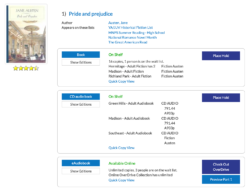Have you ever wondered how Aspen Discovery decides which edition to place a hold on? With Grouped Works, all of the editions, and therefore all of the bibliographic records, are grouped together into one search result with the option to place a hold on different formats. So, if patrons aren’t asked to choose which edition they want, how does Aspen decide which edition is best?
Before we get into the nitty gritty details, know that Aspen will always display editions in the order that it will place a hold on them. So, if you click “Show Editions” from anywhere in Aspen, the first edition listed will be the edition Aspen uses when placing a hold. Also, this article only addresses holds that are placed on grouped bibliographic records. Aspen supports item and volume level holds too and the details of how those holds differ, but Aspen still uses the first edition in the list.


Fiction versus Nonfiction
Whether or not a title is fiction or nonfiction makes a difference in which bibliographic record gets the hold. For fiction titles, Aspen assumes that the newest edition of that bestseller, the mass market paperback with the movie tie-in cover, will make the patron just as happy as the first edition published 2 years ago. There typically aren’t enough differences with fiction from one edition to the next for the average patron to be willing to wait longer to get the newer edition, so Aspen treats all editions as equals.
The case is sometimes very different for nonfiction. When the book a patron is looking for contains references to medical research that might be ongoing, or travel recommendations and website URLs to places you might want to visit, the changes between this year's edition and one that’s several years old can make a huge difference in whether or not that book will meet a patron’s information need. For nonfiction titles, Aspen will always try to place a hold on the newest edition. When the newest edition is not available, Aspen will inform the user that the title they’re requesting is checked out and ask them if they are interested in requesting a different edition that may be available faster.
Local Copies First
For libraries that belong to a consortium, local copies from their member library will be sorted before copies from other libraries in the consortium. This cuts down on courier costs and makes sure that patrons have access to their local collections first. Aspen will also prioritize records with copies belonging to a specific branch when the patron is searching from inside that branch library.
Holds Ratio is the Tie Breaker
When all else is equal, Aspen will place a hold on the bibliographic record with the best holds to copies ratio assuming that this will be the most likely to get a copy into the patron’s hands the fastest.
What about eContent?
Grouped works do combine all formats of a title into the same search result; however, each eContent provider is treated as a separate format with a separate "Place Hold" button. Aspen assumes that patrons have favorite reading apps and eContent formats differ between vendors (think of Kindle books only available from OverDrive, for example), so Aspen makes it clear from the search results which vendors are offering each title.
Occasionally a single eContent vendor will offer more than one edition of a title. When that is the case, a hold is placed on the edition with the best holds ratio, just like for physical materials and the same rules apply for fiction versus nonfiction.

Options for Pay Per Use eContent
Aspen includes some special options for eContent vendors that sell content to the library on a pay per use basis. When a title is available from a vendor where the library has prepaid and also from a vendor that offers a pay per use model, libraries have the option to hide the copy from the pay per use vendor. Of course, when all the prepaid copies are checked out, Aspen will display the pay per use copy.
This is a great way for libraries to maximize their eContent budgets while ensuring that copies of desirable books are available to patrons whenever possible.
What about patrons who need a specific edition?
Aspen removes the barrier of choosing an edition when a patron doesn’t care which edition they get or understand the differences between editions. But what about patrons who need the 1965 Oxford University Press edition of Pride and Prejudice? Through the Show Editions table, Aspen provides an individual hold button for each bibliographic record, so that when the edition matters, it’s easy for patrons to identify and place a hold on exactly what they need.
Patrons love Aspen’s Grouped Works and as a library you can see that Aspen really has put thought into optimizing how holds are placed and how to give patrons the choice to choose an edition when necessary and how to get them what they want quickly when any edition will do.
Did You Know?
Did you know that Aspen’s Grouped Works were the very first example of FRBR principles in practice?
The open source code Aspen is based on launched Grouped Works back in 2013 and ever since then libraries have been helping to perfect the algorithm to make matching bibliographic records better and better.
Read more by Jordan Fields

